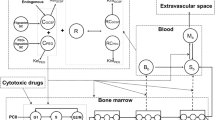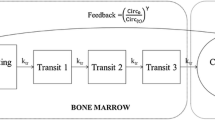Summary
We evaluated 17 clinically used anticancer drugs for their effects on total WBC and absolute neutrophil counts in BDF1 mice. These drugs were selected from three categories, based on their myelosuppressive effects in man: myelosuppression is dose-limiting; myelosuppression occurs but is not dose-limiting; or myelosuppression does not occur. The ability of each drug to cause myelosuppression in mice was determined by its effect on the neutrophil count 4 days after single-dose treatment. The neutropenic effect of the maximum tolerated dose (LD0–20) of each drug was characterized as marked (>65%↓), moderate (35%–65%↓), or minimal (<35%↓) to correspond with the three clinical categories of myelosuppression. The neutropenic effects in mice correctly predicted (true + or true-) the myelosuppressive effects in man for 13 of the 17 drugs (76%). Marcellomycin and the platinum complexes cisplatin, carboplatin, and spiroplatin did not cause neutropenia at maximum tolerated doses. These represent false-negative predictions, since the drugs are myelosuppressive in man. The results with the platinum complexes inducate that this method is not suitable as a means of screening these agents fior myelosuppression. Excluding the platinum complexes, the predictions were correct for 12 of 13 drugs (92%). Therefore, this model is considered a good predictor for the myelosuppressive effects of anticancer drugs in man (except platinum complexes) and can be used effectively to screen drugs for this toxicity. However, it is important that drugs identified by this system as being less myelosuppressive than the reference agent(s) be evaluated further, since all the incorrect predictions were false negatives.
Similar content being viewed by others
References
Baker LH, Vaitkevicius Vk (1979) The development of an acute intermittent schedule-mitomycin C. In: Carter SK, Crooke ST (eds) Mitomycin C: current status and new developments. Academic, New York, p 77
Brade WP (1981) Critical review of pharmacology, toxicology, pharmacokinetics of vincristine, vindesine, vinblastine. In: Brade W, Seeber S (eds) Proceedings of the International Vinca Alkaloid Symposium: Vindesine. Karger, New York, p 95
Bradner WT, Schurig JE (1980) Evaluation of antitumor drug side effects in small animals. Cancer Chemother Pharmacol 4: 95
Bradner WT, Schurig JE (1981) Toxicology screening in small animals. Cancer Treat Rev 8: 93
Calvert AH, Harland SJ, Newel DR, Siddik ZH, Jones AL, McElwain TJ, Raju S, Wiltshaw E, Smith IE, Baker JE, Peckham MJ, Harrap KR (1982) Early clinical studies wity cisdiammine-2,2-cyclobutane dicarboxylate platinum II. Cancer Chemother Pharm 9: 140
Carter SK, Bakowski MT, Hellman K (1981) Chemotherapy of cancer. Wiley, New York
Creaven PJ, Madajewicz S, Pendyala L, Mittelman A, Pontes E, Spaulding M, Arbuck S, Soloman J (1983) Phase I clinical trial of cis-dichloro-trans-dihydroxy-bis-isopropylamine platinum (IV) (CHIP). Cancer Treat Rep 67: 795
Dorr RT, Fritz WL (1980) Cancer chemotherapy handbook. Elsevier/North Holland, New York
Harrison SD (1981) Toxicologic evaluation of cis-diammine-dichloroplatinum II in B6D2F1 mice. Fundam Appl Toxicol 1: 382
Harrison SD (1982) Variable hose response to cytotoxic drugs: lethality, lesions and lessons. In: Fidler IJ, White RJ (eds) Design of models for testing cancer chemotherapeutic agents. Van Nostrand Reinhold, NY, p 136
Harrison SD (1983) An investigation of the mouse as a model for vincristine toxicity. Cancer Chemother Pharmacol 11: 62
Harrison SD, Burdeshaw JA, Crosby RG, Cusic AM, Denine EP (1978) Hematology and clinical chemistry reference values for C57BL/6xDBA/2F1 mice. Cancer Res 38: 2636
Joss R, Kaplan S, Goldhirsch H, Varini M, Brunner KW, Cavalli F (1983) A Phase I trial of marcellomycin with a weekly dose schedule. Eur J Cancer Clin Oncol 19: 455
Meredith RF, OKunewick JP, Khan A, Speer RJ (1984) Hematopoietic response to a potential new platinum chemotherapeutic agent. Exp Hematol 12: 378
Nicaise C, Rozencweig M, DE Marnefee M, Crespeigne N, Dodion P, Piccart M, Sculier J, Lenaz L, Kenis Y (1983) Clinical phase I trial of marcellomycin with a single dose schedule. Eur J Cancer Clin Oncol 19: 449
Ogawa M (1983) New drugs in Japan. Invest New Drugs 2: 108
Ogawa M, Inagaki J, Horikoshi N, Inoue K, Chinen T, Ueoka H, Nagura E (1979) Clinical study of aclacinomycin A. Cancer Treat Rep 63: 931
Schlein A, Schurig JE, Farwell AR, Bradner WT (1984) Comparison of the myelosuppressive effects of anticancer drugs in the mouse CFU-C. Proc Am Assoc Cancer Res 25: 327
Schurig JE, Florczyk AP, Spencer SM, Doyle GJ, Bradner WT (1983) Anticancer drug-induced myelosuppression in the ferret: A new animal model. Proc Am Assoc Cancer Res 24: 306
Vermorkin JB, ten Bokkel Huinink WW, McVie JG, Van der Vijgh WJF, Pinedo HM (1984) Clinical experience with 1,1-diaminomethylcyclohexane (sulphato) platinum II (TNO-6). In: Hacker MP, Douple EB, Krakoff IH (eds) Platinum coordination complexes in cancer chemotherapy. Nijhoff, Boston, p 330
Author information
Authors and Affiliations
Rights and permissions
About this article
Cite this article
Schurig, J.E., Florczyk, A.P. & Bradner, W.T. The mouse as a model for predicting the myelosuppressive effects of anticancer drugs. Cancer Chemother. Pharmacol. 16, 243–246 (1986). https://doi.org/10.1007/BF00293985
Received:
Accepted:
Issue Date:
DOI: https://doi.org/10.1007/BF00293985




